Mohammed Mahmud Street, also known as sharei’ uyuun al-hurriyyah (the street of the eyes of freedom), is becoming an iconic space. The street has been recently discovered by numerous photographers and passersby, not only for its mesmerizing graffiti but also for the curiosity it has raised; for the remembrance of the martyrs who were killed there; for journalists who still want to investigate the violent events that took place around that area during the course of the past year and follow-up on how the quarter is coping with the barricades and walls erected by security forces; for its dwellers who suffered not only from skirmishes but also the use of lethal- and tear- gas by anti-riot police during successive clashes; for its popular cafés juxtaposing the murals; and, last but not least, for those who still remain nostalgic about popular life around the old campus of the American University in Cairo (AUC).
Mohammed Mahmud is one of the main streets leading to Tahrir Square. It includes the back entrance of AUC. This street will remain a memorable space for the revolution because it witnessed some of the most dramatic and violent moments this past November, December, and February, including the gassing, killing and disfiguration of hundreds of protesters by Egyptian police forces. During these events, police gunmen and trained snipers had reportedly targeted (and in some case eliminated) the eyes of protesters.
In the aftermath of clashes between protesters and security forces that took place between 19 and 24 November 2011, Mohammed Mahmud Street witnessed the erection of a cement block-stones-wall that cuts it in the middle and separates it into two different areas. It also witnessed the destruction of this same wall in February 2012 by the revolutionaries and residents who at the time were engaged in similar confrontations with security forces. It later witnessed the construction of more walls and barriers that blocked various side streets leading to the main parallel Sheikh Rehan Street, the location of the monumental Ministry of Interior, currently protected by tanks and wired checkpoints.
Of greater importance, during the entire year of 2011, the wall of the old campus of AUC witnessed fantastic mutations and transformations on weekly bases, epitomized in a constant war that entailed the painting of walls. Specifically, it was (and continues to be) a war between a set of highly creative graffiti painters and the military junta’s security personnel who insisted hopelessly on repainting the walls in white to erase the mocking slogans, the daring insults against the Supreme Council of the Armed Forces (SCAF) and the hilarious drawings. Apart from mockery, and sardonic irony, the theme of commemorating the martyrs is what is most moving about these murals.
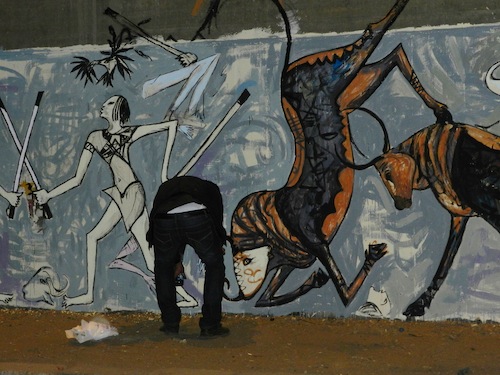
Wall on Sheikh Rehan Street, which crosses Mohammed Mahmud. Here appears artist Alaa Awad. 3 March 2012
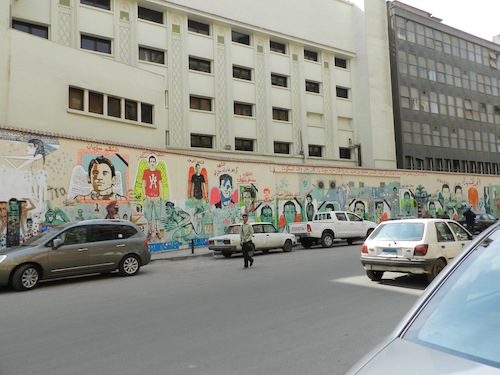
Mohammed Mahmud Street Wall. 21 February 2012
.jpg)
“The martyrs wall” on Mohammed Mahmud Street. 21 February 2012.
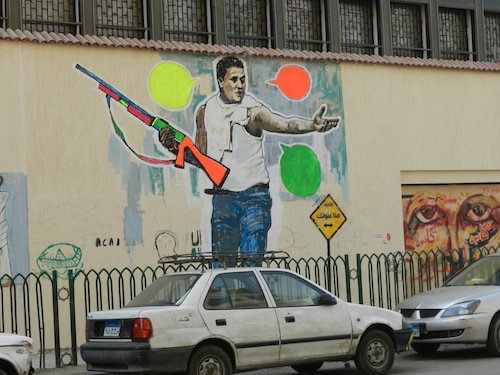
Portrait of Sambu on Mohammed Mahmud Street wall. Sambu had reportedly seized a gun from police forces in an attempt to defend fellow protesters who were being violently attacked. He was sentenced three years jail. 21 February 2012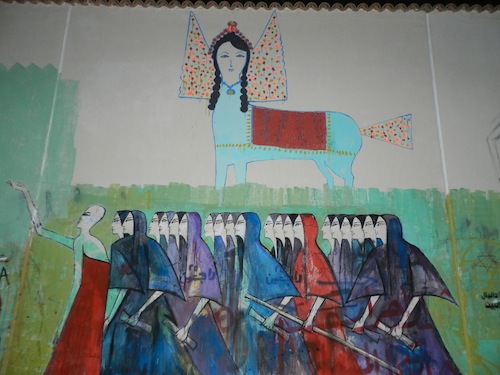

A painting inspired by popular Egyptian art. The buraq drawing had been added a day before this photo was taken. 3 March 2012

Mohammed Mahmud Street wall in the wake of violent encounters between police forces and protesters, many of whom lost their eyes. December 2011
During a million-person Friday protest last September, the ultras football fans had occupied most of Tahrir Square. They filled Mohammed Mahmud Street with music, while peacefully carrying banners and chanting their famous slogans. Many kids and young men were seen sitting on top of the AUC wall on Mohammed Mahmud, while many graffiti artists were laboriously painting the walls.
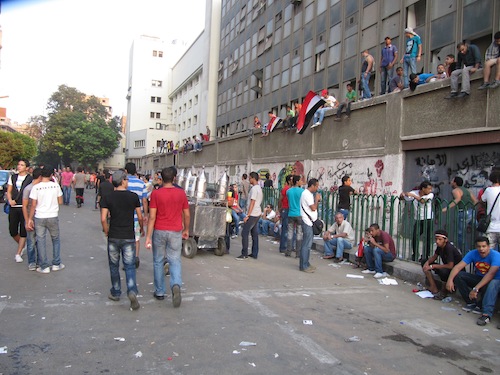
Mohammed Mahmud Street during a Tahrir Square Friday million-person demonstration, in which Ultras football fans were visibly present. September 2011
The AUC wall was erected some meters higher after the November and December battles that took place on Mohammed Mahmud Street and its surrounding areas. These events led to the looting of the headquarters of AUC and the wounding of several university security guards. In an attempt to erase the graffiti, Egyptian authorities repainted the wall with a yellowish-white paint in preparation for the commemoration of the one-year anniversary of the January 25 Revolution.
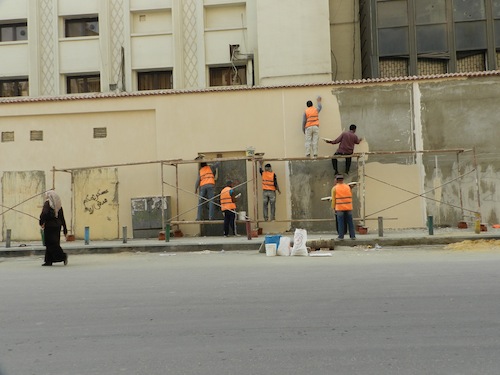
.jpg)
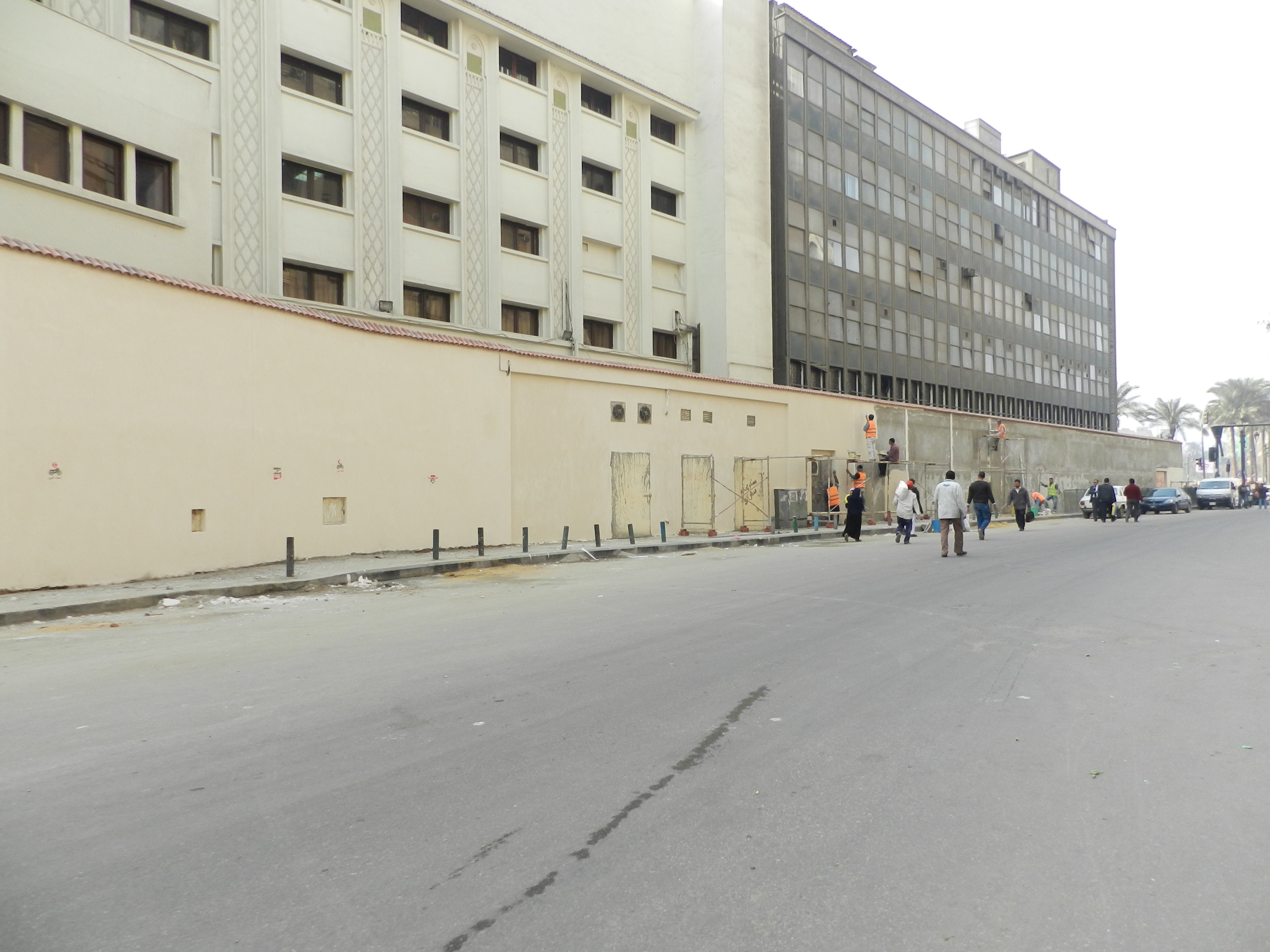 Individuals erasing graffiti in preparation for official celebrations of the first anniversary of the January 25 Revolution.
Individuals erasing graffiti in preparation for official celebrations of the first anniversary of the January 25 Revolution.
It was only a day later when the whitened wall was once again filled with fantastic drawings. The murals provided a visual expression for almost every single violent attack by security forces, which often entailed the gassing and killing of protesters. Thus the wall had graffiti displaying protestors in masks, as well as disfigured one-eyed protesters. In the wake of the massacre of the Ultras Ahlawy in Port Said, a painting appeared on the wall depicting the martyrs of the Ultras as angels resting in heaven. Another showed them being carried in a sarcophagus in a funeral in ancient Egypt. Daring talk show host Yusri Fuda, late President Gamal Abdel Nasser, female protestors who were stripped naked and publicly abused by security personnel, as well as numerous revolutionary martyrs keep on appearing and reappearing on the murals, like revenants from another world.
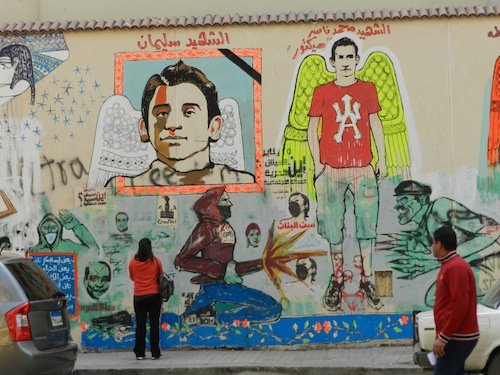
Mohammed Mahmud Street Wall. 21 February 2012
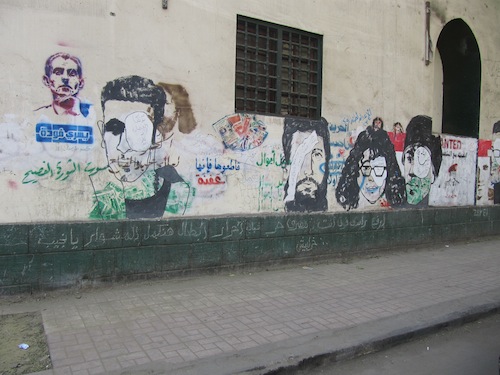
.jpg)
Mohammed Mahmud Street murals showing masks, lethal gas, individuals who lost their eyes during clashes with police forces. December 2011
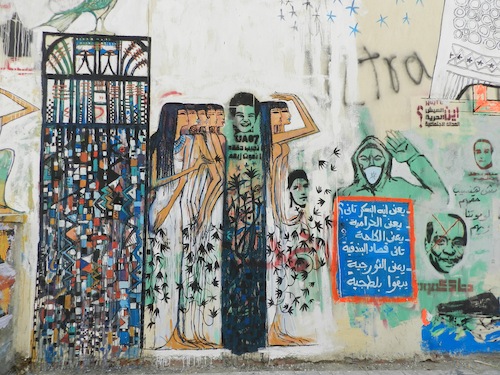
Mohammed Mahmud Street Wall. 21 of February 2012

Mohammed Mahmud Street wall repainted a day after the celebrations of the first anniversary of the January 25 Revolution. Text reads, “The street of the eye of freedom.” 26 January 2012

Mohammed Mahmud Street wall repainted with graffiti after Egyptian authorities had erased previous paintings using white paint. 26 January 2012
All the violent encounters and clashes with the junta were wonderfully recorded on the walls of this memorable street. These vivid images have virtually turned Mohammed Mahmud Street into a temple, or rather into a ‘memorial space’ that is constantly visited and photographed--at least before graffiti withers away once again. Mohammed Mahmud is also becoming a space for posing and for taking group photographs against its fantastic murals. It is not unusual to observe passersby on the Street telling bystanders and complete strangers about their experiences and memories of the revolution.

Visitors photographing and being photographed on Mohammed Mahmud Street. 21 February 2012
On 24 February 2012 the walls of Mohammed Mahmud Street were once again (and perhaps for the twentieth time) repainted with white paint. Left intact was the mural of the Ultras’ martyrs and the Pharaohs paintings located near the entrance of the AUC gate. This is in itself revealing. It was left untouched perhaps because the Ancient Egyptian funeral proceedings—or specifically fear of the “curse of the Pharaohs”—must have deterred the junta’s agents from erasing this wonderful mural. The painting must have moved the professional erasers, or, as I would call them, the professional wall-whiteners. But no one knows for how long this piece of art will survive on the wall.

Mohammed Mahmud Street wall. 21 February 2012
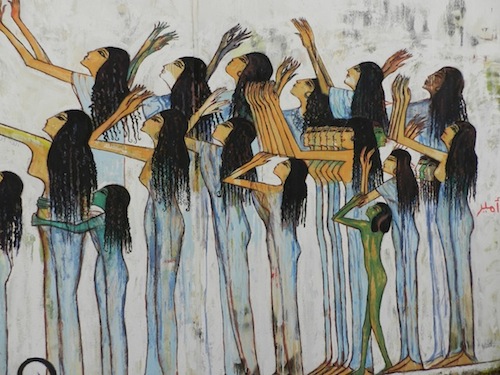
Mohammed Mahmud Street wall showing pharaonic themes painted by Alaa Awad. 21 February 2012
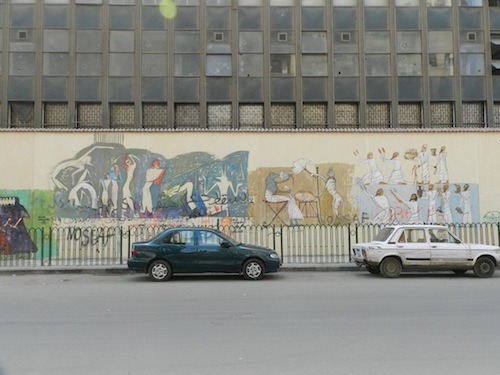
Mohammed Mahmud Street wall. 21 February 2012
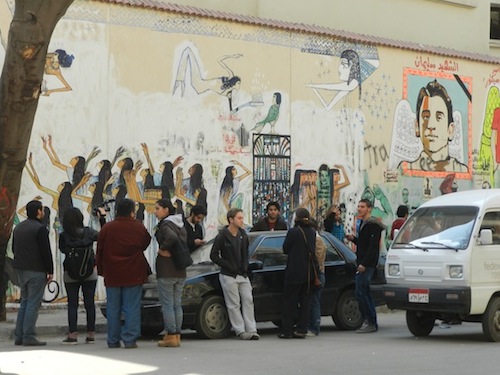
Mohammed Mahmud Street wall. 21 February 2012
Similarly, all the graffiti painted on the concrete walls or barricades located on the side streets off Mohamed Mahmoud have been erased using the white paint. But on 27 February a huge graffiti with an impressive portrait of late martyr Azharite Sheikh Emad Effat appeared on these barriers near the former library of AUC’s “Greek Campus.”
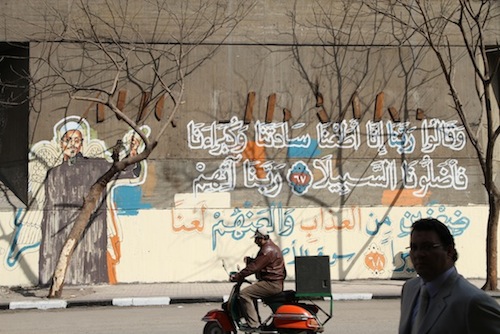
Portrait of the martyr Azharite Sheikh Emad Effat who was shot dead during clashes between protesters and security forces in December 2011.
The ebbs and flows of these artistic expressions reveal that revolutions are all about a dynamic process. It is a process that involves precarious forms of contestation that continuously foster creativity and a strong desire for recording the moment photographically, before it once again withers away.